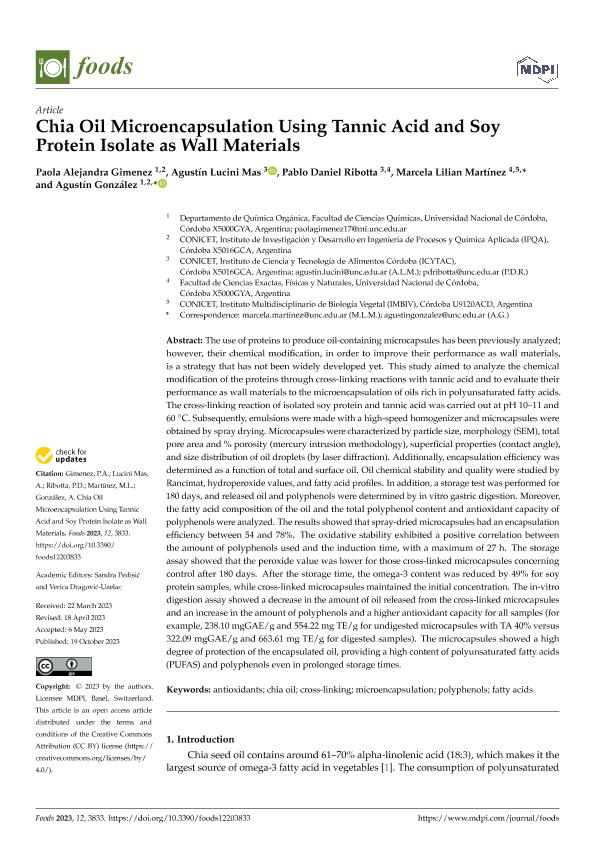Artículo
Chia Oil Microencapsulation Using Tannic Acid and Soy Protein Isolate as Wall Materials
Giménez, Paola Alejandra; Lucini Mas, Agustín ; Ribotta, Pablo Daniel
; Ribotta, Pablo Daniel ; Martinez, Marcela Lilian
; Martinez, Marcela Lilian ; González, Agustín
; González, Agustín
 ; Ribotta, Pablo Daniel
; Ribotta, Pablo Daniel ; Martinez, Marcela Lilian
; Martinez, Marcela Lilian ; González, Agustín
; González, Agustín
Fecha de publicación:
06/2023
Editorial:
Multidisciplinary Digital Publishing Institute
Revista:
Foods
e-ISSN:
2304-8158
Idioma:
Inglés
Tipo de recurso:
Artículo publicado
Clasificación temática:
Resumen
The use of proteins to produce oil-containing microcapsules has been previously analyzed; however, their chemical modification, in order to improve their performance as wall materials, is a strategy that has not been widely developed yet. This study aimed to analyze the chemical modification of the proteins through cross-linking reactions with tannic acid and to evaluate their performance as wall materials to the microencapsulation of oils rich in polyunsaturated fatty acids. The cross-linking reaction of isolated soy protein and tannic acid was carried out at pH 10–11 and 60 °C. Subsequently, emulsions were made with a high-speed homogenizer and microcapsules were obtained by spray drying. Microcapsules were characterized by particle size, morphology (SEM), total pore area and % porosity (mercury intrusion methodology), superficial properties (contact angle), and size distribution of oil droplets (by laser diffraction). Additionally, encapsulation efficiency was determined as a function of total and surface oil. Oil chemical stability and quality were studied by Rancimat, hydroperoxide values, and fatty acid profiles. In addition, a storage test was performed for 180 days, and released oil and polyphenols were determined by in vitro gastric digestion. Moreover, the fatty acid composition of the oil and the total polyphenol content and antioxidant capacity of polyphenols were analyzed. The results showed that spray-dried microcapsules had an encapsulation efficiency between 54 and 78%. The oxidative stability exhibited a positive correlation between the amount of polyphenols used and the induction time, with a maximum of 27 h. The storage assay showed that the peroxide value was lower for those cross-linked microcapsules concerning control after 180 days. After the storage time, the omega-3 content was reduced by 49% for soy protein samples, while cross-linked microcapsules maintained the initial concentration. The in-vitro digestion assay showed a decrease in the amount of oil released from the cross-linked microcapsules and an increase in the amount of polyphenols and a higher antioxidant capacity for all samples (for example, 238.10 mgGAE/g and 554.22 mg TE/g for undigested microcapsules with TA 40% versus 322.09 mgGAE/g and 663.61 mg TE/g for digested samples). The microcapsules showed a high degree of protection of the encapsulated oil, providing a high content of polyunsaturated fatty acids (PUFAS) and polyphenols even in prolonged storage times.
Palabras clave:
ANTIOXIDANTS
,
CHIA OIL
,
CROSS-LINKING
,
FATTY ACIDS
,
MICROENCAPSULATION
,
POLYPHENOLS
Archivos asociados
Licencia
Identificadores
Colecciones
Articulos(ICYTAC)
Articulos de INST. DE CIENCIA Y TECNOLOGIA DE ALIMENTOS CORDOBA
Articulos de INST. DE CIENCIA Y TECNOLOGIA DE ALIMENTOS CORDOBA
Articulos(IMBIV)
Articulos de INST.MULTIDISCIPL.DE BIOLOGIA VEGETAL (P)
Articulos de INST.MULTIDISCIPL.DE BIOLOGIA VEGETAL (P)
Articulos(IPQA)
Articulos deINSTITUTO DE INVESTIGACION Y DESARROLLO EN INGENIERIA DE PROCESOS Y QUIMICA APLICADA
Articulos deINSTITUTO DE INVESTIGACION Y DESARROLLO EN INGENIERIA DE PROCESOS Y QUIMICA APLICADA
Citación
Giménez, Paola Alejandra; Lucini Mas, Agustín; Ribotta, Pablo Daniel; Martinez, Marcela Lilian; González, Agustín; Chia Oil Microencapsulation Using Tannic Acid and Soy Protein Isolate as Wall Materials; Multidisciplinary Digital Publishing Institute; Foods; 12; 20; 6-2023; 1-15
Compartir
Altmétricas



